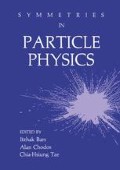Abstract
The mechanism of permanent quark confinement in Quantum Chromodynamics is cast in a language that might enable one to perform more detailed dynamical calculations. The choice of gauge condition and the topological features added to the theory by fixing the gauge are crucial in this description. However, it also becomes clear that in spite of its popularity Quantum Chromodynamics has an “identity problem”: the theory still has no sound mathematical basis. We speculate on remedies that one can envisage in the future.
Access this chapter
Tax calculation will be finalised at checkout
Purchases are for personal use only
Preview
Unable to display preview. Download preview PDF.
References
H. B. Nielsen and P. Olesen, Nucl. Phys. B61 (1973) 45
B. Zumino, in Renormalization and Invariance in Quantum Field Theory, p 367. Edited by E. R. Caianiello, Plenum, New York, 1974.
G.’ t Hooft, Nucl. Phys. B138 (1978) 1; B153 (1979) 141.
G. S. La Rue, W. M. Fairbank and A. F. Hebard, Phys. Rev. Letters 38 (1977) 1011; 42 (1979) 142, 1019E; 46 (1981) 967.
R. Slansky et al, Los Alamos preprint LA-UR-81-1378 (1981).
M. F. Atiyah, in Recent Develpments in Gauge Theories, Cargese 1979, p. 1. Edited by G.’ t Hooft et al, Plenum, New York and London. R. Bott, ibid., p. 7.
M. F. Atiyah and J. D. S. Jones, Commun. Math. Phys. 61 (1978) 97.
G.’ t Hooft and M. Veltman, Nucl. Phys. B50 (1972) 318;DIAGRAMMAR, Cern report 73/9 (1973)
M. Georgi and S. L. Glashow, Phys. Rev. Lett. 28 (1972) 1494.
A. M. Polyakov, JETP Lett. 20 (1974) 194.
G.’ t Hooft, Nucl. Phys. B79 (1974) 194.
G.’ t Hooft, Nucl. Phys. B190[FS3] (1981) 455.
P. A. M. Dirac, Proc. Roy. Soc. A133 (1931) 60; Phys. Rev. 74 (1948) 817.
G.’ t Hooft, Nucl. Phys. B72 (1974) 461.
E. Berezin et al, Commun. Math. Phys. 59 (1978) 35.
Author information
Authors and Affiliations
Editor information
Editors and Affiliations
Rights and permissions
Copyright information
© 1984 Springer Science+Business Media New York
About this chapter
Cite this chapter
Hooft, G.T. (1984). Does Quantum Chromodynamics Imply Confinement?. In: Bars, I., Chodos, A., Tze, CH. (eds) Symmetries in Particle Physics. Springer, Boston, MA. https://doi.org/10.1007/978-1-4899-5313-1_3
Download citation
DOI: https://doi.org/10.1007/978-1-4899-5313-1_3
Publisher Name: Springer, Boston, MA
Print ISBN: 978-1-4899-5315-5
Online ISBN: 978-1-4899-5313-1
eBook Packages: Springer Book Archive

